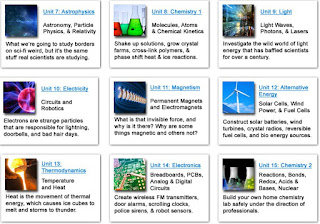About Supercharged Science
Supercharged Science is an e-Science online science curriculum created to generate a LOVE of science in your children. There are NO textbooks. No boring long ridiculous information about the cosmos. Instead, you get fun videostaught by a REAL scientist Aurora Lipper who created this program to spark life back into what she felt could be a dreary field of study. Aurora's passion for science oozes from every part of the curriculum. This program is a COMPLETE science curriculum for ages K-12 and covers the full range of sciences from Astrophysics to Life Science.
The e-Science grade 9-12 curriculum (with advanced middle school and K-8) is available for $57 per month while the e-Science grade k-8 curriculum is $37/month. With a 30-day money back guarantee. You get unlimited access to over 900 science activities, experiments, and projects. Don't forget the in-depth lesson plans, videos, and more! Every video is of real scientists performing real experiments. Something you aren't going to get anywhere else!
Our family was given a one-year subscription to the e-Science Homeschool Science Curriculum for all levels K-12.
Our Thoughts And Use of the Program
There are really two ways to best use this curriculum:1. By grade
2. By topic
If you want to explore all the science geared towards a particular grade for your student, then go for the grade. There you can discover everything that is typically covered within that grade level—and some of the more simplistic experiments typically add “advanced” exercises for the older grade levels. In fact, if you are looking for the more advanced material for 9-12, they are stashed in the Advanced Projects level on the grade-separated topic page.
By topic is ideal if you are working with multiple ages at one time, or if you desire to do more of a “buffet” sampling of the material. Within the topics, you will find materials that are geared for a wide range of ages—the program providing more advanced exercises for the upper levels, and sometimes including more advanced experiments as well.
If you go by grade, it will group the topics together—but once you click on a topic, it will have the same material and assignments and readings as if you had just opened it up to the other way—but it puts them together a bit easier for you planning a grade level year.
If I opened up the 8th-grade science, here is what I find:
 |
| 8th Grade Science is split up into three categories: Astronomy, Chemistry, Physics |
From here, we can explore the lessons and units within each of these topics.
One of the best selling points about this program is that it provides all the lesson you need for your children to adequately explore the different topics. You pick the topic, it opens up a “main” unit topic. There is a video explaining the topic and extra information for reading. From this point, you can start exploring different experiments. Each experiment has coordinating reading, but there is also a video lesson explaining the purpose of the experiment and then the video gives an explanation about the experiment itself. There are also downloadable exercises that provide additional information about the experiments, as well as extended reading and questions regarding the topic for critical thinking and comprehension. Some of the experiments even have a second set of downloadable materials for students working through the program at an upper level.
Here is a complete look at the 20 different topics currently available...
Every unit has a sidebar containing all the links needed for the unit, including the entire experiment materials list for the unit (regardless of level), separated into lesson topics. This includes even some of the optional experiments. 85% of the experiment materials are normal things you have in a science material stash (toilet paper rolls, paper cups, ping pong balls, etc), and about 15% are extra items—some might be in the tool shed, a hobby store, or Radio Shack.
Because some of the experiments are easier than others, you can do more than one in a day. We tended to get 2 experiments done per day unless the experiment was going to take longer. Because I did both of my boys together, I opted to go by topic, and they chose Mechanics. We were able to complete the entire lesson 1 on Unit 1: Force (there 9 experiments) and several of the Lesson 2 and Lesson 3 experiments. We typically did science 2-3 days a week. I preprinted my materials and then gathered up my materials—working easily off the materials list provided. Interestingly enough, the very topic they picked is one of the topics in the 8th grade curriculum which worked out perfectly for my oldest son who will be going into 8th grade.
Speaking of printing--that's really the biggest con. It's NOT open and go. There are things to be printed out and materials to be gathered. There is a lot of parent involvement and prep. I'm not a fan of all that prep. I made it work for us by printing out many lessons at once.
Both of the boys really have enjoyed this science course and would ask “Is it time to watch a lesson?” They also liked that there were quite a few lessons for each unit—exploring different aspects of the overall topic being covered.
As for favorite experiments, my youngest (age 8) says he liked the experiments with the magnets and the balloon hovercraft the best. My oldest says he liked them all and can’t pick one out—well “besides the boring experiments. I don’t like just looking at something.”
 |
| Watching one of the video lessons |
I was looking around and it looks like the website is also catering to match what they offer with experiments to one of the other top science curriculums out there--an awesome addition to the program. I also like looking at their science fair material. We are thinking about adding that to our local co-op and I know my boys would enjoy putting something together.
Here are a bunch of photos from the experiments we did as well as a few videos we took! I think you can see the fun they are having:
Static Electricity Experiments
 |
| Joy as he charges his balloon on... |
 |
| Me! Oh how they loved making my hair static |
Magnetic Field Experiments
Barrel Bridge Experiment
 |
| It was a complicated fold, so I did it myself |
 |
| Yay! I figured it out! |
 |
| Held three books and a clipboard before giving out |
Bridge Building
Recording answers to the critical thinking questions
Building the balloon hovercraft
So---will we continue using it?
Actually, during the summer I have every intention of continuing to explore some of these experiments and studies. I also want to take advantage of the free webinar classes she regularly offers. We've enjoyed them in the past, but haven't done them yet during this review. I'm thankful to have a full year of lessons and we will incorporate many of them into our science studies next year to supplement what we are already going to be working on. I also want to check out their summer science camp they have set up.
Will I continue my subscription?
Honestly, just like the last time I review this...no. It's truly an amazing resource. But the price per month is much too steep for our budget. My boys adore science, but I still cannot justify that price for us. Is it worth it? Yes. You will definitely get what you pay for if you use it properly--especially if you are trying to teach several children at the same time. So if you CAN do it...do!
Want to Know More?
I've shared with you some of the highlights from our review of the e-Science Homeschool Science Curriculum from Supercharged Science. But we only scratched the surface of what is available! I encourage you to visit other crew members to see how their children used the program and the experiments they enjoyed.*****
Supercharged Science is also getting ready to unveil a new and improved website site design to help with navigation. I took a peek at it, and it's a lovely upgrade! So that is something that will be a nice thing to see in the upcoming weeks.

















No comments:
Post a Comment